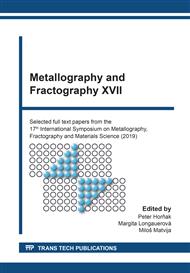p.229
p.234
p.240
p.245
p.251
p.259
p.264
p.271
p.277
Microstructural and Chemical Analysis of Military Steel from World War II as Part of Sculpture
Abstract:
The paper deals with the microstructural and chemical analysis of military steel from World War II (WWII). The sample of steel which was found in the form of totally destroyed military armoured transporter from WWII close to Hornad River near Košice city, Slovakia by well-known Slovakian artist Juraj Bartusz in the early 60-ties and nowadays analysed by advanced techniques. Juraj Bartusz created from these pieces of steel cycle of Works under name Forest (1965 – 67) which was exhibited in Paris in Museum Rodin (1968). Steel was non-standardly heat treated by melting during fire of bombs without detonators, pure ecrasite. Thus pieces of steel were exposed to extremely high temperature and change structure. Achieved structure was analysed by optical microscopy (OM) and scanning electron microscopy (SEM) supported by EDX chemical analysis. The layer of corrosion products of this sculpture exposed to rural atmosphere for 58 years in Kosice region was also analysed by both techniques.
Info:
Periodical:
Pages:
251-256
Citation:
Online since:
November 2020
Authors:
Keywords:
Price:
Сopyright:
© 2020 Trans Tech Publications Ltd. All Rights Reserved
Share:
Citation:


